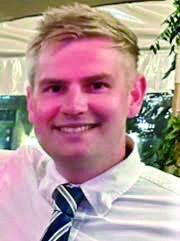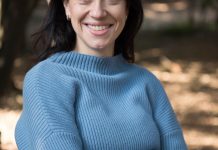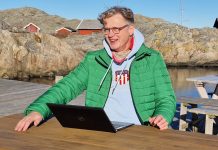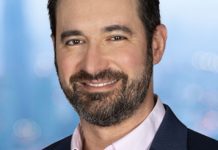U.S. offshore vessel operator, builder, and owner Edison Chouest Offshore recently launched construction of the U.S. offshore wind industry’s first ever mini-crew transfer vessel (CTV), designed by Chartwell Marine. Wind Systems recently talked with Chartwell Managing Director Andy Page about the specifics of the new CTV, and what it will mean for offshore wind development in the U.S.
How did the collaboration between Chartwell and Edison Choeust Offshore happen in order to get the CTV project going?
It was a bit of a journey really, as usual. In 2019, we were fortunate to participate in a competition for developing a future-proof small craft, which could be launched and recovered from a ship. We worked with the Carbon Trust through the Offshore Wind Accelerator (OWA) program, designed to reduce the offshore wind cost through research, development, and demonstration (RD&D). The initiative aims to overcome market barriers and establish industry best practices. The current phase involves participation and funding from nine international energy companies: EnBW, Equinor, Ørsted, RWE Renewables, ScottishPower Renewables, Shell, SSE Renewables, and Vattenfall — who together account for 75 percent of Europe’s installed offshore wind capacity.
They hosted a competition. We were one of the winners as was Robert Allen with a methanol-fueled vessel, and ESNA with its surface effect ship technology. With the award, we were able to design a new type of craft. We were able to model-test that craft, actually run it in a huge ocean basin tank, free-running with 3D-printed scaled propulsion system, electric motors, and with remote control and a motion monitoring system on board. We could actually drive it in the seas that we expect to see in the North Sea but also on the Eastern Seaboard in the U.S.
That’s how the craft initially started to exist. In the same timeline as doing that, we’ve been building boats with Blount Boats with Atlantic wind transfers as CTVs, which were getting noticed. In 2016, we were fortunate to win the most significant work boat at the work boat show in New Orleans with the Atlantic Pioneer. Subsequently, we launched the Atlantic Endeavor at the beginning of 2020. So, Chouest started to see work in CTVs in the Northeast, and they also started to hear about the daughter craft that we’ve been designing as part of the Carbon Trust project.
Those were two influencers. And then both Equinor and Ørsted were very familiar with our design. Equinor and Ørsted are were both chartering vessels from Edison Chouest, and we delivered a daughter craft for a European operator, which Equinor chartered for the Dogger Bank Wind Farm, which is currently the largest wind farm under construction in the world. The success of that boat being launched influenced confidence between Equinor and Ørsted separately and, of course, their supplier Edison Chouest.
All of these industry dynamics brought us together, and I then was fortunate to meet Michael Braid, who was based in the U.K. working for Chouest at the time. He’s now moved to the States, and I was able to present and explain the boat design. I met with other European colleagues that worked within the Chouest group, and we were able to engineer a solution that was right for Chouest’s methodology and also for their ultimate customer, Ørsted, going forward.
Were there any challenges to adapting the design for U.S. waters, particularly when it came to complying with the Jones Act?
Fundamentally, the boat needs to be built in America. We’ve had great success of doing that with Blount Boats and Derecktor Shipyards so far, and we’re also building with St. John’s Shipbuilding in Florida. We had confidence that we could design a boat that could be built in the States, having built many already. We then needed to work with Chouest for them to build it within their own shipyards, of which they have many.
Some of the changes we had to make were some of the plate thicknesses, changing the measurements to Imperial rather than metric, working with the U.S. Coast Guard and trying to procure as much material and equipment from the U.S. rather than from Europe.
A U.S. supplier, Nautical Design & Consulting, based in Louisiana, is doing the systems engineering onboard the vessel to make sure that hatches, sea strainers, valves, pipe work, all of that content is being engineered and procured from local vendors in the U.S.
And that’s probably the main things that we did to try to maximize the amount of U.S. content but, moreover, make sure that the boat can be serviced and maintained and not be reliant on a componentry we can’t get in the U.S. Very much of the mentality is we are a proven trusted company, and we don’t want have a component that we can’t deliver on our work scope.
What are the main features of the CTV, and what makes them unique as compared to other vessels in this category?
So critically, crew transfer boats go quite quickly. They take people, and they want to take them comfortably, but in the same sense they also have to almost perform tugboat-esque activities.
They have to push on to an offshore structure. They have to maintain their position; they need to be highly maneuverable, and they need to be able to safely transfer persons from the boat to an offshore structure.
It’s quite a unique work scope that not many other boats don’t need to have. It is rare that you’ve got to have such a duty cycle where you’ve got to go really fast and then you need to just have torque and hold on to an offshore structure. Chartwell, in terms of our operational experience in offshore wind, has experience in excess of 12 years. We understand the challenges in working offshore. We understand the power requirement, the type of shape of craft, how the dynamics affect onboard comfort, and how they affect the ability to transfer people. That’s what really has driven us into designing this boat for this operational requirement.
What type of research and planning went into the design of the vessel?
If I look at the boat that we’re building, it has really unique features. It has a very, very high freeboard — bow freeboard in particular — which is quite unique for a vessel of this size. Traditional boats in this size category would be much lower physically. If you were to put it alongside the most conventional commercial and leisure boats in the marina, this boat would sit very high above.
Freeboard is something we’ve researched heavily, and we’ve tested computationally and physically both at scale and at full scale. We have looked at the propulsion choice and how that is integrated into the form, trying to make sure that our propulsars don’t come out the water when we’re pushing on the offshore structure, while trying to keep them as submerged as possible, and how the flow interacts with the propellers to maximize efficiency. It also gives us that bollard push that we need to stay on the offshore structure.
For this particular requirement, the vessel also has to function with a unique feature — Ørsted’s patented Pict (GUS) Get-Up Safe system. GUS is used to pick personnel up off the deck rather than the personnel using a ladder to get up and down the turbine.
We, together with Chouest, and Ørsted, recommissioned our models that we originally did our primary model testing with, and we set them up to reflect the Get-Up Safe operation.
We changed the bow fender to suit the type of fender we will use in collaboration with Get-Up Safe. We also matched the most recorded wave frequency and period and height that we expect to see offshore.
We set the sea state to match what we thought would be the most predictable wave conditions offshore, and then we were able to test the boat in the tank to replicate that and then that gave all parties the confidence to move forward with the project. That was a great example of tri-party industry collaboration and really trying to make operations as predictable as possible within the means you’ve got. You never know until you’ve built the boat, but by doing the steps, the computational studies, the model testing, hopefully you make it as predictable as possible.
Is there a lot of trial and error involved in that process?
There is, yeah — trying different fender types, different shapes, looking at the implications of angle of approach. If you’re in a head sea condition or bow quarter, on the beam, what are the implications on the vessel? In terms of the boat, it all comes down to the operator, the person driving that boat and their skill, their precision. In relation to the Jones Act, it all comes down to that individual, that U.S. citizen, who’s going to drive that boat.
They’re the individual who’s going to really deliver a service. That’s what the critical word in offshore wind; Service. We come up with a boat, and the builder builds the boat, but ultimately, it’ll be Chouest that provides the Service, and their masters and crew will be the key component.
What projects is the CTV being built for?
The CTV is being built for Ørsted, and their U.S.-based joint venture partner, Eversource Energy, set to begin operation in summer 2024.
The daughter craft onboard the service operation vessel (SOV) can be deployed to efficiently maneuver crew across the Revolution Wind, South Fork Wind, and Sunrise Wind offshore wind farms in the Northeast US, under development by the joint venture.
Why is the CTV referred to as a daughter craft?
We call it a mini CTV or a small CTV because it’s performing crew transfer functions. I think a lot of people traditionally think of a daughter craft as being a fast rescue craft or a lifesaving piece of equipment. Of course, this would assist in the event of being needed for search and rescue purposes, but its primary function is to transfer personnel from the ship to turbines or to substations offshore.
Let’s say you’re using the ship, and it has its walk-to-work system deployed. It’s at one particular turbine, let’s say Echo 4 for example, and, all of a sudden, we hear that there is a technical issue on Delta 6. Mobilizing the ship would mean retracting the gangway — the walk-to-work system, moving the ship, taking it off DP, moving it slowly at less than 10-12 knots to its next position, and redeploying the gangway.
That takes a long time. The turbine may have lost some time in service because of the time it took to get the ship there, but also the ship is better placed, performing the routine maintenance on the asset and being there for an extended period of time. Using the daughter craft, you can put it in the water, drive it to the turbine, send your technicians and troubleshooting team to go and work on the turbine and then go back to the ship. That’s a typical operational requirement.
Additionally, if you simply need to go and get some equipment, some hardware, we have provisions for cargo onboard the CTV, the daughter craft.
If we need to go and collect some stores or run various other errands that maybe required, that’s the kind of work that this boat will typically do. It also might be used for reconnaissance work. Do we want to go and see what’s happening with the weather? Can we get some extra prediction from the CTV?
If we’re doing initial transition from construction to O&M, it’s very likely there are other assets offshore. This boat can perform functions between the different assets, the different ships, maybe barges, etc., to help be part of the working day offshore.
How will the CTV adapt to different turbine configurations that it’s obviously going to face during its mission?
The turbines themselves should all be uniform, like a standard. They should all be the same on this particular wind farm, but the substation has a different setup to the turbines. So we’ve actually designed a unique fender arrangement that can handle both the substation and the turbines. We’ve worked very closely with Chouest and with Ørsted to develop the shape required for that.
That’s part of the unique feature of this craft. If, for whatever reason through the life of the ship and therefore the daughter craft, let’s say whatever the charter term comes to an end, Chouest may want to remobilize the ship somewhere else, then the fender is configurable. We can change it to suit a different wind farm. For example, if it ever ended up down in Virginia, their turbines may be different to what we have on the Ørsted site. We’ve planned for those circumstances potentially occuring.
I know you are working with Ørsted, particularly with this one now, but is there any industry response outside of that that seems favorable to wanting to use this craft in their future projects?
Absolutely. We’ve had great success working for Equinor with our daughter craft, also with SSE in construction in Europe. We are expecting, as more SOVs come into usage in the U.S., a lot of those ships utilizing a mini CTV on board, collaborating with the ship. It’s an appealing craft. It suits the market and hopefully we will see many more being built as the U.S. market develops
Is there anything else you’d like to mention that we didn’t discuss?
If you could credit two of my colleagues as well: Robin Saunders and Thomas Payne, because they have been heavily involved in the design throuhout. Robin collaborated with Chouest in the outset, and Tom has actually been responsible for the engineering, working closely with the ship builders at Chouest, with the engineering of the kit set, as we call it. We make an IKEA-style kit set, which the shipyard assembles the boat from, and that takes a lot of brain power to deliver, so he deserves some credit for that.
More info chartwellmarine.com






























